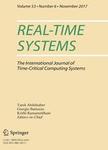版权所有:内蒙古大学图书馆 技术提供:维普资讯• 智图
内蒙古自治区呼和浩特市赛罕区大学西街235号 邮编: 010021

作者机构:Univ Illinois Champaign IL 61820 USA US DEVCOM Army Res Lab Adelphi MD USA
出 版 物:《REAL-TIME SYSTEMS》 (实时系统)
年 卷 期:2022年第58卷第4期
页 面:430-455页
核心收录:
学科分类:08[工学] 0812[工学-计算机科学与技术(可授工学、理学学位)]
基 金:DARPA [W911NF-17-C-0099] Army Research Laboratory [W911NF-17-2-0196]
主 题:Machine perception Real-time scheduling Cyber-physical systems
摘 要:This paper extends a previous conference publication that proposed a real-time task scheduling framework for criticality-based machine perception, leveraging image resizing as the tool to control the accuracy and execution time trade-off. Criticality-based machine perception reduces the computing demand of on-board AI-based machine inference pipelines (that run on embedded hardware) in applications such as autonomous drones and cars. By segmenting inputs, such as individual video frames, into smaller parts and allowing the downstream AI-based perception module to process some segments ahead of (or at a higher quality than) others, limited machine resources are spent more judiciously on more important parts of the input (e.g., on foreground objects in lieu of backgrounds). In recent work, we explored the use of image resizing as a way to offer a middle ground between full-resolution processing and dropping, thus allowing more flexibility in handling less important parts of the input. In this journal extension, we make the following contributions: (i) We relax a limiting assumption of our prior work;namely, the need for a perfect sensor to identify which parts of the image are more critical. Instead, we investigate the use of real LiDAR measurements for quick-and-dirty image segmentation ahead of AI-based processing. (ii) We explore another dimension of freedom in the scheduler: namely, merging several nearby objects into a consolidated segment for downstream processing. We formulate the scheduling problem as an optimal resize-merge problem and design a solution for it. Experiments on an AI-powered embedded platform with a real-world driving dataset demonstrate the practicality and effectiveness of our proposed framework.